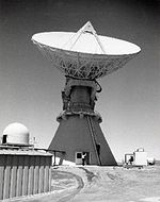
La Posta Astro-Geophysical Observatory
Encyclopedia

Naval Electronics Laboratory
The U.S. Navy Electronics Laboratory was created in 1945, with the consolidation of the Navy Radio and Sound Lab and its wartime partner, the University of California Division of War Research...
radio-telescope at Campo, CA.
Construction began in 1964 at a 3900 feet (1,188.7 m) site in the Laguna Mountains
Laguna Mountains
The Laguna Mountains are a section of the Peninsular Ranges in eastern San Diego County, California. The mountains run in a northwest/southeast alignment for approximately ....
, 65 miles (105 kilometers) east of San Diego.
History
The observatory played a major role in solar radio mappingRadio astronomy
Radio astronomy is a subfield of astronomy that studies celestial objects at radio frequencies. The initial detection of radio waves from an astronomical object was made in the 1930s, when Karl Jansky observed radiation coming from the Milky Way. Subsequent observations have identified a number of...
, studies of environmental disturbances, and development of a solar optical videometer for microwave
Microwave
Microwaves, a subset of radio waves, have wavelengths ranging from as long as one meter to as short as one millimeter, or equivalently, with frequencies between 300 MHz and 300 GHz. This broad definition includes both UHF and EHF , and various sources use different boundaries...
research.
Its 60-foot dish, which could both transmit and receive, was used for important research programs in propagation and ionospheric
Ionosphere
The ionosphere is a part of the upper atmosphere, comprising portions of the mesosphere, thermosphere and exosphere, distinguished because it is ionized by solar radiation. It plays an important part in atmospheric electricity and forms the inner edge of the magnetosphere...
forecasting which were used during a number of Apollo
Project Apollo
The Apollo program was the spaceflight effort carried out by the United States' National Aeronautics and Space Administration , that landed the first humans on Earth's Moon. Conceived during the Presidency of Dwight D. Eisenhower, Apollo began in earnest after President John F...
space launches to predict solar
Sun
The Sun is the star at the center of the Solar System. It is almost perfectly spherical and consists of hot plasma interwoven with magnetic fields...
activity that might hamper communications from the ground to the space capsules. The building located at the lower right of the dish housed a turbine-powered alternator used to provide power for the dish operation. There was insufficient power available from the national grid. In addition, the dish was computer controlled by an operator located in the building below the dish. The dish movements were monitored by close-circuit television.

